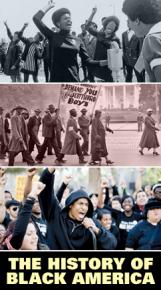From Harlem’s “Lenin” to AFL bureaucrat
tells the story of one of the most prominent Black labor leaders.
HE EARNED the nickname of "Lenin of Harlem" in his early years, but ended his life as a determined anti-communist. He was known as "Mr. Black Labor," but always protected his union presidency, even when that came at the expense of the membership. He was called the "father of the civil rights movement," but he called off a mass Black march on Washington in order to win favor with a Democratic White House.
From the late 1930s to the late 1950s, A. Philip Randolph was one of the most important Black leaders in the U.S. As president of the Brotherhood of Sleeping Car Porters and a Socialist Party member, he often clashed with the racist bureaucrats of the American Federation of Labor (AFL) and regularly battled Southern segregationists.
But his influence ultimately rested on his ability to assume the leadership of Black workers' demands for civil rights and jobs, and to channel potentially militant struggles into the arms of the Democratic Party.
RANDOLPH'S EARLY political activities seemed full of revolutionary promise. Along with Chandler Owen--Harlem's "Trotsky" to Randolph's "Lenin"--he edited The Messenger, a magazine that faced government censorship for its opposition to the First World War.
Loosely tied to the Socialist Party (SP), The Messenger caused a sensation with its call for armed self-defense by Blacks during the race riots of 1919. "A bullet," a Messenger editorial said, "is something more convincing than 100 prayers, editorials, sermons, protests and petitions."
The magazine called for a "revolution," since "when no profits are to be made from race friction, no one will longer be interested in stirring up race prejudice." Randolph and Owen supported the Russian Revolution and called themselves "Bolshevists." While critical of trade union segregation, The Messenger pointed to organized labor as the way forward for Black workers.
The Messenger was part of the remarkable Harlem milieu that included Marcus Garvey; Cyril Briggs of the pro-Bolshevik African Blood Brotherhood; and NAACP leader W.E.B. DuBois. But after the war, only Garvey's Universal Negro Improvement Association got a mass following. With its influence waning, The Messenger harshly attacked Garvey for putting nationalism ahead of working-class politics.
The History of Black America
One of Socialist Worker's earliest features was a monthly series on the history of the African American struggle in the U.S., from slavery to the present day.
But The Messenger itself veered to the right, denouncing the Jamaican-born Garvey as a foreigner who deserved deportation. Randolph criticized the left-wing split in the Socialist Party that led to the formation of the Communist Party (CP), and after 1925, he never again played a major role in the SP. By the mid-1920s, The Messenger had dropped its subtitle as "The Voice of Scientific Radicalism" and abandoned politics in favor of poetry and success stories about the Black middle class.
Randolph soon found a new career as president of the Brotherhood of Sleeping Car Porters. With Owen, Randolph had earlier helped to establish Black unions of elevator operators and tried to form a Black trade union federation. But these always took a backseat to The Messenger, and they collapsed after the war. As the magazine lost its following to Garvey, Randolph had little to risk when he accepted the invitation of militant porters to lead their new union in 1925.
For the next two years, the organizing drive at the Pullman Company made remarkable gains in the face of spies and thugs, and the dismissal of anyone suspected of joining the union. Pushed to their limit by Pullman's long hours and low wages, the porters were determined to organize.
But the effort faltered in 1928. The company's advertising dollars convinced the Black middle-class press to oppose the Brotherhood, and Pullman granted a pay raise to a sham company union. Fearful of collapse, Randolph turned to the federal government to force Pullman to recognize the union. When this effort failed, a strike seemed to be the only alternative.
The porters were ready to fight. A strike vote passed by an incredible 6,053 to 17. But Randolph took AFL President William Green's advice and called off the strike.
Although an open racist, Green found Randolph a useful ally, an anti-communist who could be pointed to in order to counter the CP's efforts to organize Blacks. Nor would the Brotherhood's all-Black membership threaten the AFL's racist Jim Crow craft unions with integration. In turn, Randolph expected the AFL to crown him as a legitimate national union leader.
But the AFL executive board tried to force the Brotherhood into becoming a Jim Crow auxiliary of the hotel workers' union, refusing to admit it as an equal member union. As a compromise, the Brotherhood district organizations were admitted as individual "federal" unions, lacking any real power.
At the same time he was collaborating with Green and the AFL despite the federation's racism, Randolph was making overtures to Pullman. In a letter to the company, he argued that it would benefit greatly by recognizing the union. "Under the influence of the Brotherhood," he wrote, "discipline would flow from the principle of attraction instead of coercion." He promised the Brotherhood's cooperation to "build a bigger and better Pullman industry to serve the nation.
At the time of its first convention in 1929, the Brotherhood membership was practically nothing. The union did not receive a full international charter from the AFL until 1936. Pullman refused to recognize the union until 1937, nearly two years after the majority of porters endorsed the Brotherhood in an election sponsored by the National Labor Board.
THE BROTHERHOOD'S victory grew out of the general upturn in the workers' movement, which gave rise to the Congress of Industrial Organizations (CIO).
The CIO had split from the AFL to organize unskilled workers in basic industry--and in so doing, it had recruited unprecedented numbers of Blacks. Seeing the CIO as a growing threat, Green revived his alliance with Randolph in order to point to the Brotherhood as a token of the AFL's "commitment" to unionize Blacks. Moreover, Randolph could be relied on to red-bait CP activists in the rival CIO.
For his part, Randolph recognized that joining the CIO would dilute his claim to be "Mr. Black Labor." In the CIO, the small Brotherhood would be dwarfed by huge industrial unions, and Randolph would be just one Black official among several. So he kept the Brotherhood in the racist AFL, claiming that no other force could push the federation to abandon its racist policies.
As the Black leader of the "respectable" labor movement, Randolph became a darling of the Democratic Party. This led even the Communist Party to support him during its Popular Front alliance with President Roosevelt in the late 1930s. Randolph was elected president of the CP-inspired National Negro Congress, a civil rights organization, but quit in 1939 when the Congress followed the CP line in support of the Hitler-Stalin pact.
But the CP's influence among Blacks had in fact been eroding since the mid-1930s, after it was disclosed that Stalin's Russia had sold weapons to fascist Italy during Mussolini's invasion of Ethiopia. When the CP renewed its support for Roosevelt, after the president again allied with Stalin in 1941, the party attacked anti-racist struggles as divisive in the face of the war effort.
By this point, Randolph--who President Woodrow Wilson had a few decades earlier called "the most dangerous Black man in America"--was a media favorite, hobnobbing with New York's Mayor Fiorello La Guardia and New Deal politicians. While the militant CIO unions stagnated during the war years and after, and the Communist Party consumed itself with infighting, the president of the Brotherhood of Sleeping Car Porters was unchallenged in his claim to be the nation's top Black leader.
Thus, Randolph was able to assert control over the growing Black protest against the racist hiring practices in the booming defense industries and segregation in the military.
In early 1941, Randolph initiated a call for a 10,000-strong march on Washington to protest discrimination. His proposal met with overwhelming support, attracting thousands of Black Communist Party supporters who were bitter at opposition to the march from the CP, which claimed protesting would weaken the war effort. Randolph soon upped the expected total to 100,000 and set a date of July 1.
But when Randolph canceled the march after Roosevelt issued Executive Order 8802, Black militants rightly denounced him as a sell-out. While the Order ostensibly outlawed racist hiring practices in the war industries and the government, it left the Jim Crow military untouched. Nor did it provide for any real powers of enforcement. Randolph had traded the enormous power of a mass movement for personal influence at the White House.
After the war, Randolph again took up the issue as his League for Nonviolent Disobedience Against Military Segregation demanded that President Harry Truman integrate the armed forces. Truman, trying to fight off a Republican challenge in Congress, agreed, promising Black civil rights legislation in exchange for Black electoral support in 1948.
But there was another side to the deal. Randolph joined Truman's anti-communist witch-hunt, cheering the expulsion of communists and militants from the CIO. In 1952, he traveled with Socialist Party colleague Norman Thomas to the Far East, where, speaking for the CIA-sponsored Campaign for Cultural Freedom, he denounced "Russian slavery" and hailed U.S. "progress" on civil rights. Still a prominent Black leader, he gave a left-wing cover to McCarthyite repression as it was inflicted on the left in the labor and civil rights movements.
RANDOLPH'S ROLE in the anti-communist crusade earned him a vice-presidential position in the 1955 merger of the AFL and the CIO. Although Randolph's already small Brotherhood rapidly lost membership with the decline of passenger train travel, AFL-CIO President George Meany found Randolph a useful figurehead.
But the civil rights groundswell renewed itself in the 1950s, pushing Randolph to take a more strident tone in his criticisms of Jim Crow unionism. At the 1959 AFL-CIO convention, Randolph urged the federation to force all-white railroad unions to admit Blacks. "Who in hell appointed you as guardian of the Black members in America?" an irritated Meany shouted at Randolph. Two years later, the AFL-CIO censured Randolph for creating a "gap that has developed between organized labor and the Black community."
Meany needn't have worried. Randolph's rediscovered militancy was short-lived. In 1963, he was put forward by the conservative wing of the civil rights movement to become chair of another March on Washington. From this position, Randolph did everything he could to keep the march a moderate affair.
Ironically, Randolph's sidekick, Bayard Rustin, was considered one of the troublemakers in the 1963 march. Yet by this point, he and Randolph were both conservatives within the movement, denouncing Black nationalist Malcolm X as a "racist" and supporting the Vietnam War. Randolph and Rustin backed United Federation of Teachers President Albert Shanker in a racist strike in 1968 against affirmative action and Black community control of New York City schools.
Randolph's career reached another low point in 1965 when Meany created an A. Philip Randolph Institute in the AFL-CIO. Randolph now declared that the problem of racism in organized labor had been "solved." Speaking to 1,000 delegates at the Federation's convention--15 of whom were Black--Randolph announced his resignation as president of the Negro American Labor Council and praised Meany's "success in fighting racism in the union movement."
How did the "most dangerous Black man in America" become a fixture among the conservative leaders of the labor movement? Historian Manning Marable attributes this to the weakness of Randolph's ideas, an emotional anti-communism and an inability to grasp the progressive aspects of Black nationalism.
But even the most militant of Black union leaders or politicians--which Randolph certainly was not--are limited by their position in society. Elected to government or union office, such leaders must maintain a balancing act between their Black constituencies on the one hand and the pressures of the business and political elite on the other. Because of this balancing act, in the end, they oppose any real challenge to the status quo.
A version of this article was first published in two parts in the May and June 1986 issue of Socialist Worker.



